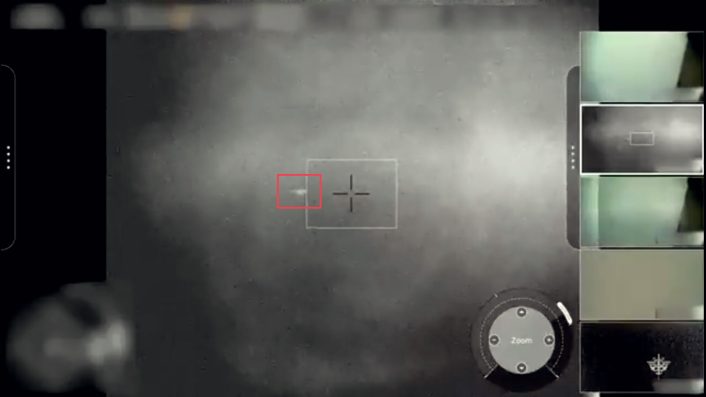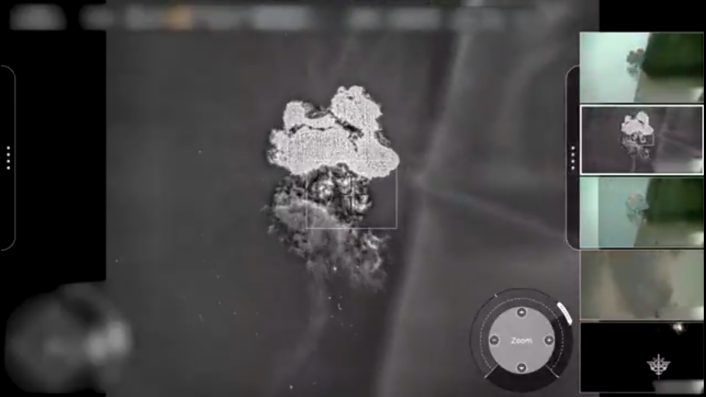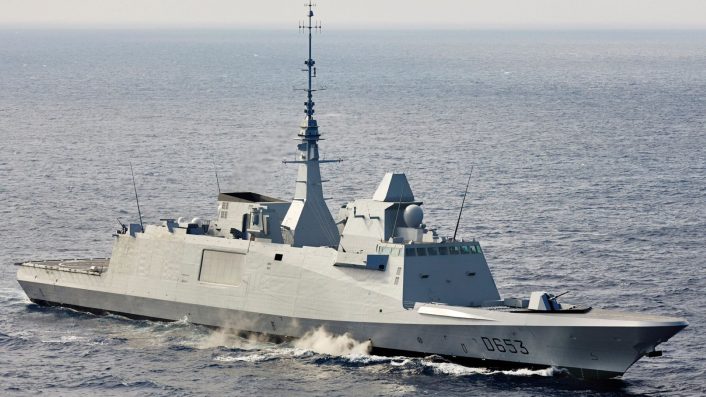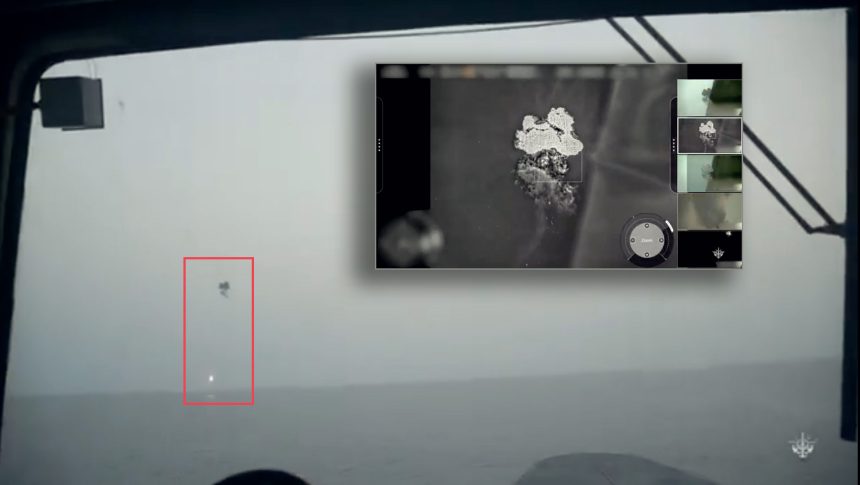The use of the Italian-made OTO Melara 76 mm Super Rapid gun to destroy the Houthi drone allowed to preserve the larger and costlier ASTER surface-to-air missiles.
The French military’s Joint Staff released a video on Apr. 18, 2025, showing an action-packed engagement of a Houthi drone destroyed by an Aquitaine-class FREMM frigate’s OTO Melara 76 mm main gun. It is not clear when the engagement took place.
En mer Rouge, destruction par une frégate française d’un drone tiré depuis le Yémen.
Nos armées continuent leur engagement pour garantir la libre circulation maritime. pic.twitter.com/VgGzyYhiKz
— Sébastien Lecornu (@SebLecornu) April 17, 2025
France’s defense minister Sébastien Lecornu also posted a day earlier an image from an EO/IR (Electro-Optical/Infrared) system showing the explosion of the drone. Identifying the location as the Red Sea, the Joint Staff described the action as an “Interception by a French frigate of an aerial drone coming from Yemen, threatening maritime traffic.”
📍Red Sea | Interception by a 🇫🇷 frigate of an aerial drone coming from Yemen, threatening maritime traffic.
➡️ Constant vigilance to ensure freedom of navigation and maritime security from Suez to Hormuz. pic.twitter.com/ARGCV6X3JL
— The 🇫🇷 Joint Staff – Military operations (@FrenchForces) April 18, 2025
Video
The final part of the 35-second video shows footage from an EO/IR system, as seen on the gunnery crews’ console, of what appears to be a fixed wing UAS (Unmanned Aerial System) after being struck by a round from the ship’s Italian-made OTO Melara Super Rapid Gun Mount (SRGM).
The video begins with footage from the bridge showing the OTO Melara gun firing seven rounds amid frenzied instructions from a watch crew member. A small object flying past the bridge’s windows has been identified as the gun barrel’s rubber cover.
 The drone, marked by the red rectangle, as seen by the EO/IR sensor. (Image credit: The French Joint Staff – Military Operations on X)
The drone, marked by the red rectangle, as seen by the EO/IR sensor. (Image credit: The French Joint Staff – Military Operations on X)A small mid-air explosion in the distance indicates the target being eliminated and falling into the sea engulfed in flames. This appears to be corresponding to the footage from the EO system and the other video feeds on the gunner’s console.
 Infrared and thermal images from the gunner’s console showing the Houthi drone exploding after being struck by a round from the OTO Melara gun. (Image credit: The French Joint Staff – Military Operations on X)
Infrared and thermal images from the gunner’s console showing the Houthi drone exploding after being struck by a round from the OTO Melara gun. (Image credit: The French Joint Staff – Military Operations on X)Initially mistaken for another drone or a bird, the French Joint Staff, in response to queries on the thread, clarified the object flying past the window was a rubber cover which “protects the gun barrel from seawater and still allows for emergency firing.” This means the rubber cover does not have to be manually removed and the rounds can fire right through it.
Comme ça ? pic.twitter.com/m4ZboSZ3Zq
— Manuel Guillaumont 🇫🇷&🇺🇦 (@MGuillaumont) April 18, 2025
French Navy Aquitaine-class FREMM frigates
Within the broader FREMM (Frégate Européenne Multi-Mission) program, the Marine Nationale’s FS Aquitaine frigates are a sub-class, with greater ASW (Anti-Submarine Warfare) capability. The FS Alsace-class lead ship and its sister vessel FS Lorraine specialize in anti-air capabilities. Other ships in the Aquitaine-class are the FS Provence, FS Languedoc, FS Auvergne, FS Bretagne and FSD Normandie.
France has deployed its warships in support of EUNAVFOR’s (European Naval Force’s) Operation Aspides, a separate deployment that mutually supports the U.S.-led Operation Prosperity Guardian in the Red Sea in a “purely defensive” yet mutually supportive format. The Aquitaine-class FREMM ships carry 16 SYLVER A43 VLS (Vertical Launch Silo) cells firing the ASTER 15 air defense missiles and 16 A70 VLS cells carrying MdCN cruise missiles.
Aerial target detection, tracking and control of anti-air weapons is perrformed by a Thales Herakles multi-purpose electronically-scanned radar. The leading maritime-strike weapon is the Exocet MM40 Block 3 AShM (Anti-Ship Missile).
The employment of the Italian OTO Melara 76 mm SRGM to destroy the Houthi drone allowed to preserve the ASTER SAMs (Surface-to-Air Missile). Such guns usually carry diverse ammunition for different anti-surface, anti-air contacts offering various effects.
The latest engagement might have employed proximity-fused rounds releasing metal ball bearings for a fragmentation effect. The gun is also license-manufactured by India’s state-owned BHEL (Bharat Heavy Electricals Limited) for Indian Navy warships.
 The French Navy’s Aquitaine-class FREMM frigate FS Languedoc. (Image credit: Naval Group)
The French Navy’s Aquitaine-class FREMM frigate FS Languedoc. (Image credit: Naval Group)France’s Red Sea actions
Deployed in the region since late 2023, the Marine Nationale initially used its Aster-15/30 SAMs along with 76 mm OTO Melara SRGM, seen in a short clip of a longer publicity feature from a early 2024 documentary feature of the Aquitaine-class frigate FS Alsace’s actions.
The FREMM DA Alsace returned to France on Apr. 4, 2024 after “nearly 3 months at sea and helped ensure maritime security,” under EUNAVFOR ASPIDES. On Mar. 20, 2024 the Marine Nationale also used an NH90 Caiman naval helicopter to shoot down a Houthi drone using an onboard gun mounted on the doors.
In an Apr. 2024 interview with Le Figaro, the FS Alsace’s commander Jérôme Henry said about the deployment against the Houthis: “We didn’t necessarily expect this level of threat. There was a rather surprising and very significant level of uninhibited violence. The Houthis don’t hesitate to use drones that fly low over the water, to detonate them on merchant ships, and to fire ballistic missiles.”
Houthi challenge
As noted in previous reports at The Aviationist, the Houthis and Iran have posed a significant ‘asymmetric’ challenge to larger, more technologically advanced Western warships and fighters by throwing cheap and scalable drones, anti-ship cruise and ballistic missiles at them.
These initially required employing costlier systems, like the U.S. Navy’s RIM-162 ESSM (Evolved Sea Sparrow), F/A-18 Super Hornets from USN aircraft carriers and F-15E Strike Eagles deployed in the CENTCOM (Central Command) AOR (Area of Responsibility) firing AIM-120 AMRAAM (Advanced Medium-Range Air-to-Air Missile) and AIM-9 Sidewinders short-range AAMs.
EUNAVFOR ASPIDES 🇪🇺 | Interception par l’hélicoptère de la frégate 🇫🇷 d’un drone aérien en provenance du Yémen menaçant le trafic maritime civil en mer Rouge.
➡️ La priorité: assurer la liberté de navigation et la sûreté maritime de Suez à Ormuz https://t.co/pJjwPK2c8b pic.twitter.com/KQ8DD17hRL
— Armée française – Opérations militaires (@EtatMajorFR) March 20, 2024
These missiles cost $1 million a piece for the AMRAAMs and $500,000 for the Sidewinders, while the fighters employing them are worth tens of millions per airframe.
The Houthi projectiles, worth not more than $15,000-$20,000, are meanwhile made using commercially available, often recreational drone and aviation components. These include PCBs (Printed Circuit Boards), SoC (Systems on Chips), microelectronics, servo motors, embedded systems, and, as some analysts believe, DIY (Do-It-Yourself) jet and push-propeller piston engines.
Beside being easy to assemble and scale up in a nearly invisible industrial footprint to have a large attritable arsenal of such OWA (One-Way Attack) projectiles, the above systems’ off-the-shelf civilian nature can also easily escape the sanctions oversight. Their sale is hard to track as the end users can source them from various legitimate second and third party companies not tied to Iran or Yemen.
Effort to adapt
It took successive U.S. governments several decades to be able to crack down on banned aerospace parts smuggling by North America-based Iranians, sending F-4 Phantom II and F-14 components to Tehran – purchasing them through smaller and intermediary aviation services companies. While Iran’s frontline military aircraft fleet now has the poorest airworthiness, it used that time to develop its own ballistic and cruise missile arsenal.
The USAF also adapted to the challenge, as The Aviationist reported in Feb. 2025 about the service fielding F-16s in the CENTCOM AOR employing the APKWS II in the air-to-air role against Houthi projectiles since 2024. The laser-guided APKWS II addressed the skewed cost ratio in using the costlier AIM-9 Sidewinder and AIM-120 AMRAAM against drones worth not more than $15,000-$20,000.
Defense giant BAE Systems also developed a new variant of the APKWS II sporting an infrared seeker.









